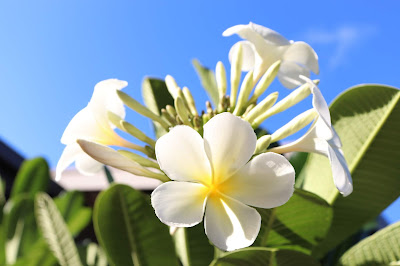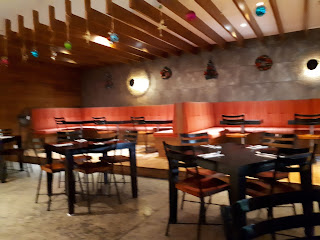 |
| Bula! Welcome (Photo taken by and copyright Maria Ngo) |
My hope with this series of posts is that what I've learnt will prove helpful to you in your prep as you head that way. Perhaps it might save you some headache and money and make your trip more enjoyable.
 |
| A musical bula welcome (Photo taken by and copyright Maria Ngo) |
Some of these questions were those that I'd asked but could not find a straight answer for before we left on our journey.
 |
| Welcome the Fijian way (Photo taken by and copyright Maria Ngo) |
In this post I'm going to tackle the question of sun screen, souvenirs and pharmaceuticals. Okay, 'drug scene' was a stretch, well, drug stores, chemists and pharmacies are after all part of the 'drug scene', just not the illicit kind (*big cheesy grin and a wink here*).
 |
| You said smile (Photo taken by and copyright Maria Ngo) |
Sunscreen
One of the questions I had before I went was "How much sunscreen should I pack? Will I need it there? Can I buy them there? How much will they cost? Is it worth the extra weight?" Mind you, we were going for 18 days and we were planning to spend most of that time outdoors.
 |
| A traditional dance (Photo taken by and copyright Maria Ngo) |
Here in Australia, we are familiar with the 'Slip slop slap' skin cancer campaign that promotes slipping on a t-shirt, slopping on the 50+ sunscreen and slapping on a hat, seeking shade or shelter and also sliding on some glasses. So when we're heading overseas to spend time in the sun, sea and/or surf, sunscreen is on our minds.
So how much does a tube of sunscreen cost? We paid FJD13.95 for a 100 ml tube in December 2018 from a pharmacy in Nadi.
And how much would a family of four adults use? Well, we went through two of those tubes after we finished what we'd brought with us. Some of us also wore long sleeved rash tops for about half of the 18 days we were there while others had it on the whole time. We also wore shorts most of the time.
What I'm saying is that we were not dressed in bikinis but we still went through a fair bit of sunscreen. We saw many instances though of what can happen when someone doesn't. Not pretty.
 |
| Having fun in the sun (Photo taken by and copyright Maria Ngo) |
There were other reasons why I eventually went full body rash-suits. You can read about it in my fourth post - Snorkelling, sea creatures and sea lice.
Do you really need sunscreen? Let me answer it this way. We are of Asian descent and we generally do not burn straight away. But when you spend hours in the sun whether in the sea, pool or poolside or beach, you cannot ignore the sun's effect.
 |
| After 18 days, can you tell which one is the Fijian? (Photo taken by and copyright Maria Ngo) |
On our first day, we spent a number of hours catching up on our sleep lounging under a palm shelter, with our hats, sunscreen and sarong (the day was simply too beautiful to do otherwise); I had evidently missed a patch near my neck, and the effects was obvious the next day. Luckily for me, I had packed some aloe vera gel to combat such eventualities.
 |
| Lounge away (Photo taken by and copyright Maria Ngo) |
Sarongs and souvenirs
Speaking of sarongs, can you get these easily and at a good price in Fiji? After all, these appear to be part of the original local attire. Before I went I thought that this would be one of my souvenirs from Fiji. Well, as it turned out, after we'd done Malaysia and Thailand, the price of sarongs do not compare well in Fiji. So I came home with other souvenirs instead. I'm not saying that you shouldn't get any or that it's exorbitant.
Can you expect to see market stalls like in Thailand or Malaysia where the competition is stiff and you are simply spoilt for choice for things like sarongs? I was expecting that, but it turned out to be otherwise. I found sarongs in less than a handful of shops in Nadi town and Port Denarau as well as the resort. And those outside the resort appeared to be part of the largest and most reputable souvenir chain in Fiji - Jack's of Fiji. There were also other smaller souvenir shops.
On the whole, I'd say that souvenir shopping is more sedate and confined. You certainly won't get harassed by entrepreneurs hawking their wares in your face as you try to relax on the beach.
 |
| Jack's of Fiji (Photo taken by and copyright Maria Ngo) |
One kind of souvenir did seem to abound though in Nadi, Port Denarau and some of the islands that we visited; and that was hand crafted timber carvings. It was such items that I found myself spoilt for choice -- there were kava bowls, turtles, urns, sharks, traditional weapons, face masks, etc. in various types of timber and sizes.
 |
| Beautiful timber crafts (Photo taken by and copyright Maria Ngo) |
Just as well we had allowed ourselves a fair bit of luggage space and weight - timber is definitely heavier than sarongs, and a bit harder to accommodate because of their shape.
 |
| Dolphins, sharks and other animal carvings (Photo copyright Maria Ngo) |
How much were these? Small ones were around the FJD40 to FJD50 mark. Larger ones can go for several thousand FJD.
 |
| Inside a souvenir timber crafts shop (Photo taken by and copyright Maria Ngo) |
And before you ask, yes, you can use credit cards at most of these shops, but a 2.5% to 3% transaction fee appear to be the norm.
But if you plan to purchase these on the islands during an island tour, cash is the preferred payment. I also found that these were also less dear.
 |
| Which one will I choose - at Vusama Village (Photo taken by and copyright Maria Ngo) |
One "ploy," if you can call it that, among the souvenir sellers is to invite you to participate in a kava ceremony. It is quite an interesting experience, but then you do feel obligated to buy something then.
 |
| A kava ceremony (Photo taken by and copyright Maria Ngo) |
 |
| Kava root (Photo taken by and copyright Maria Ngo) |
Other popular local souvenirs include pearls (definitely not your bargain basement variety) and personal care products made from coconut oil and dilo oil. The latter again, are not light.
In the main, the shops in Nadi seemed to cater to local needs. For more information on what you can see in Nadi, check out my post 18 days in Fiji (# 2) From Denarau Island to Nadi town centre and market.
 |
| A general store in Nadi serving the locals (Photo taken by and copyright Maria Ngo) |
 |
| What will I find in Nadi town? (Photo taken by and copyright Maria Ngo) |
 |
| Shop where the locals go (Photo taken by and copyright Maria Ngo) |
 |
| No spruiking here (Photo taken by and copyright Maria Ngo) |
Another thing we worried about was Australian border control and timber handicrafts. The Fijians are obviously aware of this issue as well because they all claim to have treated their work and are in the main very well sanded, smoothed down and without crevices for little critters to hide in.
The 'drug scene'
And what of the 'drug scene'? Are there reputable chemists/pharmacists in Nadi? I saw a few of these and they appeared to stock the usual medication for travellers as well as locals. The range was limited though. For example, I found travel sickness tablets but it wasn't the one that I was used to but it did its job. How much was it? A packet of 12 tablets of Kwells cost FJD19.95.
 |
| Supplies from the chemist (Photo taken by and copyright Maria Ngo) |
As for sunscreen, you don't need to go to a drugstore to get them, even the resort supermarket/grocery store sold them. They were however dearer than the chemist in Nadi town.
Bottom line, bring your travel medication (e.g. sunscreen, travel sickness tablets, anti histamines, insect bite creams, insect repellent, antiseptic creams, aloe vera gels, gastro tablets, panadol/tylenol etc.) with you. But if you need to replenish your supplies, yes, you are more than likely to get something that will most likely do the job, but it might not be the brand you are after, and be prepared to pay for it. As for prescription medication, I will just affirm what the official sites say, bring them with you, don't count on filling your script when you are in Fiji.
 |
| Yes we put it back straight after the photo (Photo taken by and copyright Maria Ngo) |
Oh, and once you head out to the resorts on the smaller islands, the cost of sunscreen increases further still and your chances of getting other medications decreases.
 |
| Emergency supplies on Mantaray Island resort (Photo taken by and copyright Maria Ngo) |
So basically, travel like a good scout, and you'll do well - always be prepared. Sure, the local town centre can provide them, but if you want to spend every moment luxuriating in a well deserved holiday, then pack what you can. But if you are on an extended visit and have limited luggage space, budget accordingly for needed supplies and pick them up in Nadi.
Thank you so much for joining me in this post! Vinaka vaka levu! Hope to catch you at my next post.
 |
| Frangipani (Photo taken by and copyright Maria Ngo) |
 |
| I think I want one in my hair too (Photo taken by and copyright Maria Ngo) |
PS If you found this post helpful, do click like, share it and follow! Would appreciate it so much.






















































